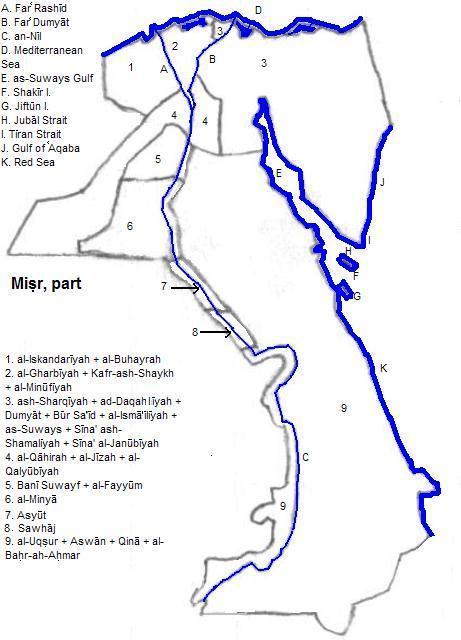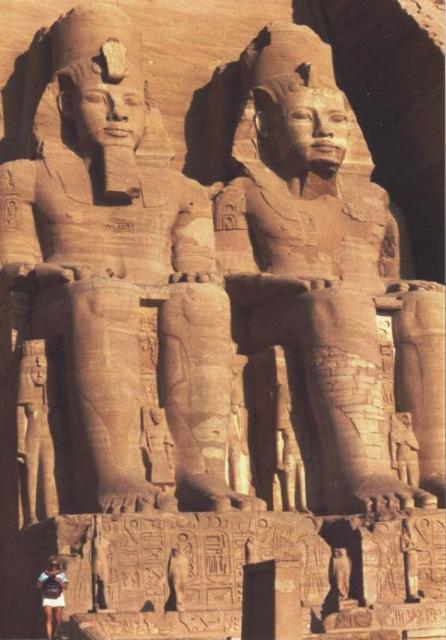
| To Duval Family Home Page | Africa | Asia |
| To Chris Home Page | the Maghreb | |
| To Earth (Geography Home Page) | Miṣr (Egypt) |
The Nile (an-Nūl), the world's longest river, enters from the south and flows north through eastern Miṣr (Egypt) to the Mediterranean Sea, dividing the Sahara desert in two, the Far' Rashid (Rosetta Branch) and the Far' Dumāt (Damietta Branch). Its valley marks the western edge of this area. The river provides irrigation for valley and delta farms. To the northeast beyond the desert is the Sina' (Sinai) Peninsula, a mountainous triangle east of the Suwayz (Suez) Canal. In southermost Miṣr is Lake Nasser formed by damming the Nile.
Almost all of Egypt's people, more than 60 million, crowd along the Nile and in its delta. Nearly everyone speaks Egyptian Arabic
There are two metropolitan areas centered in the country with more than a million residents. See Table of eastern Miṣr Cities.

People arrived here soon after they left Ethiopia, around 100,000 years ago. Thousands of years ago according to Christopher Ehret, speakers of the Boreafrasian dialects of Proto-Afroasiatic moved here when the climate was wetter, giving rise to the Berber and Egyptian peoples over time.
In the far south were non-Egyptian speakers of the land later called Nubia. Nubian speakers arrived there in the middle of the first millenium CE. There are still speakers of two Nubian languages: Nobin and Kenzi but they are switching to Arabic as they become urbanized.
The area has several World Heritage Sites:
| Name | Location, if not rural |
| Abu Mena | |
| Ancient Thebes and its Necropolis | al-Uqṣur |
| Historic Cairo | al-Qāhirah |
| Memphis and its Necropolis--the Pyramid Fields from Giza to Dahshur | al-Qāhirah metropolitan area and nearby |
| Nubian Monuments from Abu Simbel to Philae | |
| St. Catherine Area | |
| Wade Al-Hitan (Whale Valley) |
There are oil ports at Ras Shukheir, Sidi Kirir, 'Ain Sukhna and Wadi Feirān, a commodity port at Suways (Suez) and a phosphate port at Safaga. In the core of the an-Nil (Nile) Delta, and offshore near it, are oil and gas fields.
Besides the big cities and World Heritage Sites, tourists visit the resort of Sharm ash Shayk.

Statues at Temple of Ramesses II, Abū Sunbul (Abu Simbel)
north
northeast
southeast of Sinai
east of just north of the tip of Sinai
east
south, from the southeast
south, from the south center of this area
south, from the southwest of this area
west
1. Egypt in English.
2. The Red Sea in English.
3. Luxor in English.
4. Faiyum in English.
5. Gizeh or Giza in English.
6. Cairo in English. Mars (the planet) in literal translation.
7. Alexandria in English.
8. The West in English
9. The East in English
10. Port in English.
11. Suez in English
12. North Sinai in English.
13. South Sinai in English.
14. Some regard Arabic as one language but speakers cannot understand each other's spoken dialects. Some would regard Egyptian Bedawi (Bedouin) Arabic and Sai'id Egyptian Arabic as separate languages. Some might group the former with one of the Saudi dialects. Some might group Western Bedawi (Arabic with spoken Egyptian (Cairene) Arabic but it is the same dialect as Libyan Spoken Arabic, which is similar to some of the Maghrebi dialects.
15. The same migration gave rise to the Semitic peoples of nearby Asian. One of them left inscriptions in the Sina' (Sinai) that look like the ancestral language to Arabic.
16. Elites eventually did not believer in anthromorphic super-beings.